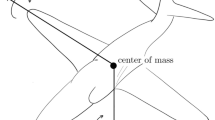Abstract
In this paper, a path planning approach is developed and demonstrated for an unmanned aerial vehicle (UAV); the algorithm is applicable for autonomous robot path planning also. The main contribution of the paper is the development of an extension to the Bellman–Ford algorithm that enables incorporation of constraints directly into the algorithm during run-time. This, therefore, provides a framework for path planning, which does not cause violation of the dynamical constraints of the vehicle (or robot), such as its angle of turn. Furthermore, a procedure for computing a number of sub-optimal paths is developed so that a range of options is available for selection; the optimality of the paths is also proved. These sub-optimal paths are generated in an order of priority (optimality). An objective function is developed that models different conflicting objectives in a unified framework; these objectives can be assigned different weights. The objectives may include minimizing the length of the path, keeping the path as straight as possible, visiting areas of interest, avoiding obstacles, approaching the terminal point from a given direction, etc. The algorithm is tested for complex mission objectives, and results are discussed.










Similar content being viewed by others
Notes
The Global Positioning System.
References
Gang L, Min-zhou D,Tao X, Liang W. Multi-agent path planning for unmanned aerial vehicle based on threats analysis. In: Proceedings of the 3rd International workshop on intelligent systems and applications (ISA), (Wuhan, China); 2011.
Kan E, Lim M, Yeo S, Ho J, Shao Z. Contour based path planning with {B}-spline trajectory generation for unmanned aerial vehicles (UAVs) over hostile terrain. J Intell Learn Syst Appl. 2011;3(3):122–130.
Kala R, Shukla A, Tiwari R. Dynamic environment robot path planning using hierarchical evolutionary algorithms. Cybernet Syst. 2010;41(6):435–454.
Kala R, Shukla A, Tiwari R. Robotic path planning using evolutionary momentum-based exploration. J Exp Theor Artif In. 2011;23(4):469–495.
Wzorek M, Doherty P. Reconfigurable path planning for an autonomous unmanned aerial vehicle. In: Proceedings of the 16th International conference on automated planning and scheduling, American Association for Artificial Intelligence; 2006. p. 438–441.
Bortoff S. Path planning for UAVs. In Proceedings of the American Control Conference; 2000. p. 364–8.
Filippis LD, Guglieri G, Quagliotti F. A minimum risk approach for path planning of uavs. J Intell Robot Syst-Special Issue Unmanned Aerial Vehicles. 2011; 61: 203–19.
McLain TW, Beard RW. Trajectory planning for coordinated rendezvous of unmanned air vehicles. In Proceedings of the AIAA Guidance, Navigation, and Control Conference; 2000.
Schouwenaars T, DeMoor B, Feron E, How J. Mixed integer programming for multi-vehicle path planning. In Proceedings of the European Control Conference, (Portugal); 2001. p. 2603–8.
Shanmugavel M, Tsourdos A, White B. Collision avoidance and path planning of multiple uavs using flyable paths in 3d. In Proceedings of the 15th International Conference on Methods and Models in Automation and Robotics; 2010.
Kamal WA, Gu DW, Postlethwaite I. Real time trajectory planning for UAVs using MILP. In Proceedings of the CDC-ECC Conference, (Seville, Spain); 2005.
Richards A, Bellingham J, Tillerson M, and How J. Coordination and control of multiple UAVs. In Proceedings of the AIAA Guidance, Navigation, and Control Conference; 2002.
Richards A, How J. Aircraft trajectory planning with collision avoidance using mixed integer linear programming. In Proceedings of the American Control Conference; 2002.
Richards A, How J, Schouwenaars T, Feron E. Plume avoidance maneuver planning using mixed integer linear programming. In Proceedings of the AIAA Guidance, Navigation, and Control Conference; 2001.
Taha HA. Operations Research: An Introduction, 6 ed. Prentice-Hall Inc., New Jersey; 1997.
Helgason RV, Kennington JL, Lewis KR. Cruise missile mission planning: a heuristic algorithm for automatic path generation. J Heurist. 2001; 7:473–94.
Kim Y, Gu DW, Postlethwaite I. Real-time path planning with limited information for autonomous unmanned air vehicles. Automatica. 2008; 44:696–712.
Sipahioglu A, Yazici A, Parlaktuna O, Gurel U. Real-time tour construction for a mobile robot in a dynamic environment. J Robot Auton Syst. 2008; 56:289–384.
Guzman JL, Berenguel M, Rodriguez F, Dormido S. An interactive tool for mobile robot motion planning. J Robot Auton Syst. 2008; 56:385–480.
McFarland MB, Zachery RA, Taylor BK. Motion planning for reduced observability of autonomous aerial vehicles. In Proceedings of the 1999 IEEE International Conference on Control Applications; 1999. p. 231–5.
Murphy RR, Introduction to AI robotics. Cambridge: MIT Press; 2000.
Huang H-P and Chung S-Y, Dynamic visibility graph for path planning. In Proceedings of IEEE/RSJ International Conference on Intelligent Robots and Systems, (Sendai, Japan); 2004.
Ilari J and Torras C. 2D path planning: a configuration space heuristic approach. Int J Robot Res. 1990; 9:75–91.
Neus M and Maouche S, Motion planning using the modified visibility graph. In Proceedings of the IEEE International Conference on Systems, Man and Cybernetics. 1999; 4: 12–5.
Bhattacharya P and Gavrilova ML. Voronoi diagram in optimal path planning. The 4th International Symposium on Voronoi Diagrams in Science and Engineering; 2007. p. 38–47.
Takahashi O, Schilling RJ. Motion planning in a plane using generalized Voronoi diagrams. IEEE Trans Robot Autom. 1989; 5:143–50.
Cormen TH, Leiserson CE, and Rivest RL, Introduction to algorithms. Cambridge: MIT Press; 1990.
Nilsson NJ. Principles of Artificial Intelligence. Palo Alto, CA: Tioga Publisher Company 1980.
Author information
Authors and Affiliations
Corresponding author
Rights and permissions
About this article
Cite this article
Samar, R., Kamal, W.A. Optimal Path Computation for Autonomous Aerial Vehicles. Cogn Comput 4, 515–525 (2012). https://doi.org/10.1007/s12559-011-9117-0
Received:
Accepted:
Published:
Issue Date:
DOI: https://doi.org/10.1007/s12559-011-9117-0




